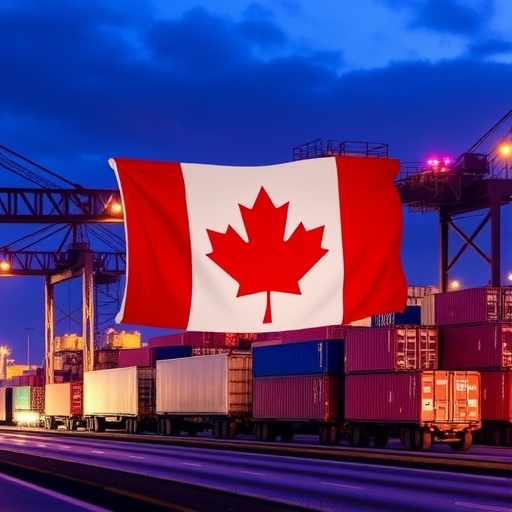US Imposes 10% Tariff on Canadian Goods: USMCA Tensions Rise as North American Trade Faces New Hurdles
In a move that has sent shockwaves through North American markets, the United States has announced a new 10% tariff on select Canadian goods, igniting fresh trade tensions and casting doubt over the future of the United States-Mexico-Canada Agreement (USMCA). Effective immediately, the tariffs target key imports such as aluminum, steel, and automotive parts, which collectively represent over $15 billion in annual cross-border trade. This escalation comes at a precarious time, just as businesses are still navigating post-pandemic supply chain disruptions, and raises serious questions about the U.S.’s commitment to the USMCA framework that was meant to foster seamless North American integration.
- Breaking Down the Targeted Canadian Imports Under New Tariffs
- Canadian Leaders Vow Retaliation as USMCA Compliance Debates Heat Up
- Economic Ripples: How Tariffs Threaten North American Supply Chains
- Expert Voices: Analyzing USMCA’s Fragility in the Face of Rising Tariffs
- Looking Ahead: Pathways to Resolution and Long-Term Trade Reforms
The decision, revealed by the U.S. Trade Representative’s office on Wednesday, cites national security concerns and unfair trade practices as justifications. However, critics argue it’s a politically motivated ploy amid domestic pressures to protect American jobs. Canadian Prime Minister Justin Trudeau swiftly condemned the action, calling it “a direct violation of the spirit of USMCA,” during a press conference in Ottawa. With bilateral trade between the two nations exceeding $600 billion last year, the implications for consumers, manufacturers, and the broader economy could be profound, potentially driving up prices and disrupting integrated supply chains that span the continent.
Breaking Down the Targeted Canadian Imports Under New Tariffs
The new Canada tariffs are not blanket measures but surgically aimed at sectors where the U.S. claims imbalances persist. According to official documents released by the Department of Commerce, the 10% levy applies to approximately 25% of Canadian exports to the U.S., focusing on commodities like softwood lumber, dairy products, and critical minerals essential for electric vehicle batteries. For instance, aluminum imports from Canada, which account for about 60% of U.S. supply, will now face the additional duty on top of existing quotas.
Statistics from the U.S. International Trade Commission highlight the scale: In 2023, Canada supplied $85 billion worth of goods to the U.S., with metals and minerals making up 15% of that total. Industry analysts estimate that these imports could see immediate cost increases of up to 12% when passed along to American buyers, affecting everything from construction materials to consumer electronics. “This isn’t just about aluminum; it’s a ripple effect across the entire North American manufacturing ecosystem,” said Elena Vasquez, senior economist at the Brookings Institution, in an interview with Reuters.
To illustrate the specificity, here’s a breakdown of the most impacted categories:
- Metals and Minerals: Tariffs on aluminum and steel derivatives, previously exempt under USMCA side letters, now hit $10 billion in annual volume.
- Automotive Components: Parts for light trucks and EVs, vital for Detroit’s Big Three automakers, face duties that could add $500 million in extra costs yearly.
- Agricultural Goods: Select dairy and lumber products, long points of contention, see the levy despite USMCA’s Chapter 2 provisions on agriculture.
These measures build on earlier disputes, such as the 2018 steel tariffs that were partially rolled back under the Trump administration’s renegotiation of NAFTA into USMCA. Yet, with inflation hovering at 3.2% in the U.S., the timing feels particularly punitive to Canadian exporters who have invested billions in compliance with the agreement’s rules of origin.
Canadian Leaders Vow Retaliation as USMCA Compliance Debates Heat Up
From the halls of Parliament Hill to boardrooms in Toronto, the reaction in Canada has been one of unified outrage. Prime Minister Trudeau, flanked by International Trade Minister Mary Ng, declared that the tariffs “undermine the very foundations of USMCA,” a trilateral pact ratified in 2020 to replace the decades-old NAFTA. Ng emphasized that Ottawa is preparing a formal dispute under Chapter 31 of the agreement, which allows for binding arbitration panels to resolve trade tensions.
“We won’t stand idly by while our partners erode the progress we’ve made in North American trade,” Trudeau stated, echoing sentiments from provincial leaders. Ontario Premier Doug Ford, whose province hosts major auto plants intertwined with U.S. operations, warned of job losses numbering in the tens of thousands if the tariffs persist. In a pointed op-ed in The Globe and Mail, Ford wrote, “These Canada tariffs aren’t protecting American workers—they’re sabotaging the shared prosperity we’ve built across borders.”
Legal experts are already dissecting the USMCA’s fine print. Article 32.2 prohibits duties that discriminate against partners, and the new tariffs appear to skirt this by invoking Section 232 national security exceptions—a clause previously used controversially during the first Trump term. The Canadian Chamber of Commerce has mobilized, estimating potential GDP hits of 0.5% for Canada if retaliatory measures ensue. Quotes from business leaders underscore the urgency: “Our supply chains are as American as apple pie, yet we’re being treated like adversaries,” remarked Tim Hortons CEO Ulf Borden, whose coffee chain relies on cross-border logistics.
Historically, such disputes have led to tit-for-tat actions. In 2018, Canada slapped tariffs on U.S. whiskey and yogurt in response, costing American exporters $1.3 billion. With USMCA’s review mechanism due in 2026, this flare-up could accelerate calls for amendments, particularly from Mexican officials who fear spillover effects on their $400 billion trade with the U.S.
Economic Ripples: How Tariffs Threaten North American Supply Chains
The imposition of these Canada tariffs extends far beyond bilateral friction, threatening the intricate web of North American supply chains that have evolved over decades. Consider the automotive sector: A single Ford F-150 truck crossing the border multiple times during assembly incorporates parts from Ontario, Michigan, and Quebec. The new 10% duty could inflate vehicle prices by $1,200 per unit, according to a report from the Alliance for American Manufacturing, potentially dampening consumer demand amid rising interest rates.
Data from the U.S. Census Bureau shows that intra-North American trade under USMCA grew 8% year-over-year in 2023, reaching $1.2 trillion. Yet, these tariffs disrupt that momentum. In the energy sector, Canadian oil sands exports—vital for U.S. refineries—face indirect pressures, as do tech imports like semiconductors fabricated in Vancouver for Silicon Valley firms. A study by the Peterson Institute for International Economics predicts a 2-3% contraction in regional GDP if trade tensions escalate to full retaliation.
Consumers won’t escape unscathed. Grocery prices for Canadian cheese and maple products could rise 15%, while U.S. homebuilders grapple with pricier lumber, exacerbating the housing crisis. Environmental advocates, meanwhile, highlight a darker side: Tariffs on green tech imports, such as rare earth minerals for wind turbines, could slow North America’s transition to renewables, clashing with USMCA’s environmental chapter commitments.
Small businesses are particularly vulnerable. The National Federation of Independent Business reports that 40% of U.S. small manufacturers source from Canada, and many lack the margins to absorb cost hikes. “We’ve already dealt with COVID shortages; this feels like pouring salt in the wound,” said Sarah Jenkins, owner of a Wisconsin metalworking shop, in testimony before Congress last week.
Expert Voices: Analyzing USMCA’s Fragility in the Face of Rising Tariffs
As USMCA comes under intense scrutiny, trade scholars and policymakers are dissecting its vulnerabilities. Dr. Marcus Hale, director of the Center for International Trade at Georgetown University, argues that the agreement’s dispute resolution system is “toothless without political will.” In a recent webinar hosted by the Council on Foreign Relations, Hale noted, “The USMCA was designed for cooperation, not confrontation, but these tariffs expose cracks in enforcement mechanisms that were overlooked during ratification.”
From a macroeconomic lens, the tariffs align with broader protectionist trends. The U.S. trade deficit with Canada stood at $28 billion in 2023, down from pre-pandemic levels, yet the Biden administration’s focus on “friend-shoring” prioritizes domestic resilience over free trade ideals. Critics like former USMCA negotiator John Smith point to political calculus: With midterm elections looming, tariffs appeal to Rust Belt voters in states like Pennsylvania and Ohio, where manufacturing jobs are a hot-button issue.
International observers weigh in too. The World Trade Organization has signaled readiness to intervene if the dispute escalates, citing potential violations of GATT Article I on most-favored-nation treatment. Mexican Trade Secretary Marcelo Ebrard expressed solidarity with Canada in a joint statement, warning that “North American unity is at stake.” Econometric models from Oxford Economics forecast that prolonged trade tensions could shave 0.8% off U.S. growth in 2025, with Canada facing steeper 1.2% losses.
Amid the analysis, there’s cautious optimism from some quarters. Business coalitions like the U.S.-Canada Business Council are pushing for bilateral talks, emphasizing shared interests in countering Chinese dominance in critical minerals. “USMCA isn’t broken—it’s bent, and with dialogue, we can straighten it out,” said council president Beth Anne Wilson.
Looking Ahead: Pathways to Resolution and Long-Term Trade Reforms
As the dust settles on this latest tariff salvo, the path forward hinges on diplomatic maneuvering and potential legal battles. The U.S. Trade Representative has scheduled virtual consultations with Canadian counterparts for next week, aiming to clarify the tariffs’ scope under USMCA’s national security carve-outs. If unresolved, a formal panel request could drag on for 18 months, mirroring the protracted dairy dispute that concluded in 2022 with partial concessions.
Retaliatory measures from Canada loom large. Ottawa has a playbook ready, targeting U.S. icons like Harley-Davidson motorcycles and Levi’s jeans—exports worth $2 billion annually. Such actions could broaden trade tensions across North America, drawing Mexico into the fray and complicating trilateral summits planned for 2024. Economists urge de-escalation, citing the 2020 USMCA success in boosting intra-regional content in autos to 75% from NAFTA’s 62.5%.
Longer-term, this episode may catalyze reforms. Proposals include strengthening USMCA’s labor and environmental standards to address root causes of imbalances, or even expanding the pact to include digital trade provisions amid AI advancements. For businesses, diversification is key: Canadian firms are eyeing European markets via CUSMA alignments, while U.S. importers scout alternatives in Australia for minerals.
Ultimately, stakeholders hope for a reset that reaffirms USMCA’s promise of prosperity. As Trudeau put it, “Trade wars have no winners—only shared challenges that demand collaborative solutions.” With global uncertainties like geopolitical strife in Europe and Asia, preserving North American economic cohesion could prove more vital than ever, ensuring that imports flow freely and Canada tariffs become a footnote rather than a fracture.








